Oracle Advanced Supply Chain Planning (ASCP) is a comprehensive, Internet-based planning solution that decides when and where supplies (for example, inventory, purchase orders and work orders) should be deployed within an extended supply chain. This is the supply planning function. Oracle ASCP addresses the following key supply planning issues:
• How do I plan my supply chain in the least amount of time possible?
• How do I minimize the number of plans and iterations?
• How do I plan my entire supply chain?
• How do I involve my trading partners?
• How can I access my plan from anywhere?
• How do I keep improving my plans?
• How can I plan all manufacturing methods?
The key capabilities of Oracle ASCP are:
• Holistic Optimization, Planning, and Scheduling. Oracle ASCP can plan all supply chain facilities simultaneously. Short-term detailed scheduling and long-term aggregate planning are supported within a single plan. This single plan also supports multiple manufacturing methods, including discrete, flow, project, and process manufacturing.
• Finite Capacity Planning and Scheduling. Oracle ASCP generates feasible supply chain plans that consider both resource and material constraints.
• Optimization. Users can easily configure Oracle ASCP to optimize specific business criteria. No programming is necessary to access Oracle ASCP’s powerful mathematical optimization capabilities.
• Backward Compatibility. Oracle ASCP’s component architecture allow it to be deployed against any combination of Oracle 11 and Oracle 11i transaction systems.
• Workflow-Driven Exception Messaging. Oracle ASCP’s exception messages alert planners to critical issues across the extended supply chain. Workflows that drive these exceptions route data to and feedback from trading partners as required, thus effectively involving them in the supply chain planning process.
• Global Accessibility. Oracle ASCP’s database-centric architecture stores plan data in a central planning server database. These data are accessible from Oracle Advanced Supply Chain Planning anywhere via a simple browser. It is possible for multiple planners to simultaneously access data from a single plan.
• Integrated Planning and Execution. Oracle ASCP’s Advanced Planner Workbench user interface not only displays plan results, but also allows planners to execute planning recommendations. Planners do not have to move to the transaction system to perform plan execution.
• Simulation Capability. Oracle ASCP allows many types of changes to supply, demand, plan options, and resource profiles to simulate changing business conditions. You can generate a plan considering all the changes that have been entered via the Planner’s Workbench. Unlimited numbers of scenarios can be simulated and compared using online planning, copy plans, and exceptions.
Objective
The objective of this document is to provide technical instructions of implementing a distributed multi node Oracle Advanced Supply Chain Planning system on your existing Oracle Application 11i System.
Assumption / Pre implementation requirements
Oracle Advanced Planning Suite has component architecture that separates the transaction data and associated processing (for example, inventory receipts and order entry) in a source instance from the planning calculations done in a destination instance. This allows planning calculations to be done on a different physical machine than the machine that performs transactions and results in better system response. It also allows planning calculations (demand planning, inventory planning, supply planning and order promising) to be applied simultaneously to information from across multiple source instances, which is useful when transaction information for a global supply chain is spread across multiple instances.
The source can be any ERP system, but out-of-the-box integration to the Oracle Advanced Planning Suite destination instance (planning server) exists if the source is Oracle Applications Release 11.0 or 11i. The planning server is an 11i instance.
Both source and destination database instances must be on the same major release of the Oracle database;
We are going to do a two machine ASCP implementation.
The basic requirement for both the machines is that of Oracle 11i E Business Suit.
Source System also called as “ERP System” and “Transaction System”.
Destination System also called as “ASCP System” and Planning System”.
Both the Oracle Applications 11i E-Business Suite are on release 11.5.10.2.
Patching the Source System (ERP System) and the Destination (ASCP system)
Task By: Apps DBA
Before beginning the functional setup of the source instance(s) and destination, the following patches must be applied that will create several new concurrent programs, flexfields, profile options, and database objects on the database.
If these patches have any prerequisite patches, you will have to apply all the prerequisite patches before applying the main patches.
Note that these patches can be applied at the same time on both the systems. Also note that most of the patches are to be applied on both the systems.
Note that we are using Oracle Applications 11.5.10.2 E Business suite and hence most of the patches may not be required to be applied. To confirm this use the following sql script connected to the Oracle Application Database as “APPS” user.
SET LINESIZE 120
COLUMN APPLICATION_SHORT_NAME FORMAT A20
SELECT
BUG_ID, APPLICATION_SHORT_NAME, BUG_NUMBER, CREATION_DATE, ARU_RELEASE_NAME
FROM AD_BUGS
WHERE BUG_NUMBER LIKE ‘%&BUG_NUMBER%’
ORDER BY 4
Pass the patch number when asked for the Bug Number and check whether the bug / patch exist in the Oracle Application database. If the query returns row (showing the presence of the patch) then you don’t require applying this patch.
Before applying patches please go through the readme files and associated notes (if present) for each patch. Before beginning the installation of the source / destination patches, count all (if any) invalid database objects. If after the patches are installed there are more invalid objects than before, there was a problem with the patch application. First try to resolve them before going to next step.
Do the required pre install steps before applying each patch and then after applying do the post-installation steps.
Patch the Source System (ERP System)
The following patches are required to be applied on the Source system:
1. 4185358
2. 2700001
3. 3551142
4. 4183434
5. 4240365
6. 4039921
7. 4392144
8. 4366346
9. 4863176
Prepare a work sheet to identify whether the patch is required to be applied on the Oracle Application Source system using above given sql script and whether it requires any pre-requisite patches.
Sr. No. Patch Note Required (Y/N) Pre-requisites
1. 4185358 Y None for 11.5.10.2
2. 2700001 N NR for 11.5.10.2
3. 3551142 Y None
4. 4183434 N NR for 11.5.10.2
5. 4240365 278055.1 Y None for 11.5.10.2
6. 4039921 N NR for 11.5.10.2
7. 4392144 278055.1 Y None for 11.5.10.2
8. 4366346 278055.1 Y 3629717
9. 3629717 Y None for 11.5.10.2
10. 4863176 Y None for 11.5.10.2
Hence the sequence of applying the patches is as follows:
1. 4185358
2. 3551142
3. 4240365
4. 4392144
5. 3629717
6. 4366346
7. 4863176
Patch the Destination (ASCP) system
The following patches are required to be applied on the Destination system:
1. 4185358
2. 4231863
3. 4210584
4. 4359934
5. 4392144
6. 4366346
7. 4392231
8. 4039921
9. 4523322
Prepare a work sheet to identify whether the patch is required to be applied on the Oracle Application Destination system using above given sql script and whether it requires any pre-requisite patches.
Sr. No. Patch Note Required (Y/N) Pre-requisites
1. 4185358 278055.1 Y None for 11.5.10.2
2. 4231863 278055.1 Y 4185358
3. 4210584 Y None
4. 4359934 278055.1 Y 4185358
5. 4392144 278055.1 Y None for 11.5.10.2
6. 4366346 278055.1 Y 3629717
7. 3629717 Y None
8. 4392231 Y None
9. 4039921 N NR for 11.5.10.2
10. 4523322 278055.1, 278052.1 Y 4392231, (4863176 on Source Side),
11. 4297568 Y None
Hence the sequence of applying the patches is as follows:
1. 4185358
2. 4231863
3. 4210584
4. 4359934
5. 4392144
6. 3629717
7. 4366346
8. 4392231
9. 4039921
10. 4523322
11. 4297568
ILOG Libraries and Executables
The patch 4297568 is for “ILOG Libraries and Executables”. Apply this patch only if you are using 11.5.10.2.
1. Log in to each concurrent processing server node as the owner of the Applications file system.
2. If the $SHT_TOP/lib/ilog/5.1 directory already exists, backup any files or directories that it contains.
3. Unzip the ilog51lib.zip file, located in the sht/lib directory of this patch, into the $SHT_TOP/lib directory. This will create the ilog/5.1 subdirectory if it doesn’t already exist.
4. Change directories to $SHT_TOP/lib/ilog/5.1/SUN_OS5.
5. Copy the library files from the current directory to the $SHT_TOP/lib/ilog/5.1 directory.
On UNIX Sun Solaris, the files are
i. libconcert.a
ii. libcplex.a
iii. libhybrid.a
iv. libilocplex.a
v. libschedule.a
vi. libsolver.a
6. Use AD Administration to relink these executables [Under DB Node]:
i. Oracle Constraint Based Option (MSO): MSONEW
ii. Oracle Inventory Optimization (MSR): MSRNEW
iii. Oracle Manufacturing Scheduling (WPS): WPCWFS
iv. Oracle Work in Process (WIP): WICDOL, WICMEX, WICMLX
Create Database link
Task By: Apps DBA
Create database link on Source system to Destination system
A database link must be established on the source instance that points to the destination (11i planning) instance. This database link will be referenced in a newly created profile option, MRP: ATP Database Link, discussed in Step 7.
This database link will also be used, along with a database link established on the destination instance, in setting up the instances on the planning server.
First make necessary entry of the Target / Destination instance Oracle Database in the tnsnames.ora file of the Source Instance Oracle Database tier (TNS_ADMIN location).
Create Database link as follows:
create database link
connect to APPS identified by
using ‘’;
APPS-TRNS1.USA.COM>select INSTANCE_NAME, HOST_NAME from v$instance;
INSTANCE_NAME HOST_NAME
—————- ———————————————————–
TRNS1 indsapp001
APPS-TRNS1.USA.COM>show user
USER is “APPS”
APPS-TRNS1.USA.COM>ed
Wrote file afiedt.buf
1 create database link coe2
2 connect to apps identified by *****
3* using ‘coe2’
APPS-TRNS1.USA.COM>/
Database link created.
APPS-TRNS1.USA.COM>select INSTANCE_NAME, HOST_NAME from v$instance@coe2;
INSTANCE_NAME HOST_NAME
—————- ———————————————————–
COE2 indapp002
APPS-TRNS1.USA.COM>select count(*) from fnd_user@coe2;
COUNT(*)
———-
101
APPS-TRNS1.USA.COM>
Note the database link name created on this source / ERP system Oracle database for connecting planning / destination server Oracle database.
Create database link on Destination system to Source system
First make necessary entry of the Source / Transaction instance Oracle Database in the tnsnames.ora file of the Target / Planning Instance Oracle Database tier (TNS_ADMIN location).
Create Database link as follows:
create database link
connect to APPS identified by
using ‘’;
APPS-COE2.USA.COM>select INSTANCE_NAME, HOST_NAME from v$instance;
INSTANCE_NAME HOST_NAME
—————- ———————————————————–
COE2 indsapp002
APPS-COE2.USA.COM>show user
USER is “APPS”
APPS-COE2.USA.COM>ed
Wrote file afiedt.buf
1 create database link trns1
2 connect to apps identified by ****
3* using ‘trns1’
APPS-COE2.USA.COM>/
Database link created.
APPS-COE2.USA.COM>select INSTANCE_NAME, HOST_NAME from v$instance@trns1
2 ;
INSTANCE_NAME HOST_NAME
—————- ———————————————————–
TRNS1 indapp001
APPS-COE2.USA.COM>select count(*) from fnd_user@trns1;
COUNT(*)
———-
100
APPS-COE2.USA.COM>
Note the database link name created on this planning / destination Oracle Database server for connecting to source / ERP system Oracle database.
Prepare the Source System
Create an Advanced Supply Chain Planner responsibility
Task By: Apps DBA
You must create a responsibility in the source (ERP) instance that conforms to the specifications.
Responsibility Name : Advanced Supply Chain Planner
Application : Oracle Manufacturing
Description : Used for running ASCP Report
Menu : SCP_TOP_4.0
Data Group Name : Standard
Application : Manufacturing
Request Group : All SCP Reports
Application : Oracle Master Scheduling/MRP
Responsibility key :
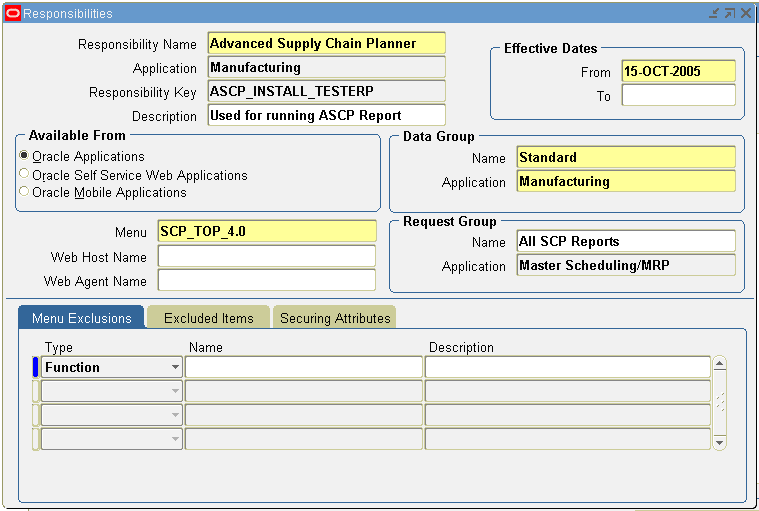
This responsibility is used to run the concurrent program Refresh Snapshot during all data collection runs.
Warning: The responsibility name must match as “Advanced Supply Chain Planner” exactly.
Check Profile Option Name
Task By: Apps DBA and Functional Consultant
The Create Planning Flexfileds concurrent program creates new segment definitions in existing descriptive flex fields to hold data that may be required for constrained and /or optimized planning. The program will not populate profile values.
• MSO: Penalty cost factor for late demands (Organization) flexfield attribute
• MSO: Penalty cost factor for exceeding material capacity (Organization) flexfield
• MSO: Penalty cost factor for exceeding resource capacity (Organization) flexfield
• MSO: Penalty cost factor for exceeding transportation capacity (Organization)
• MSO: Penalty cost factor for exceeding resource capacity (Resource) flexfield
• MSO: Penalty cost factor for exceeding transportation capacity flexfield attribute
• MSO: Penalty cost factor for late forecasts
• MSO: Penalty cost factor for late sales orders
Create APS partition on the Source System
Task By: Apps DBA
Login to Oracle Applications 11i Source System.
Select “System Administrator” responsibility.
Navigate to Security Responsibility Request
Enter in the query mode in the “Request Group” screen and query for “All MSC Reports” .
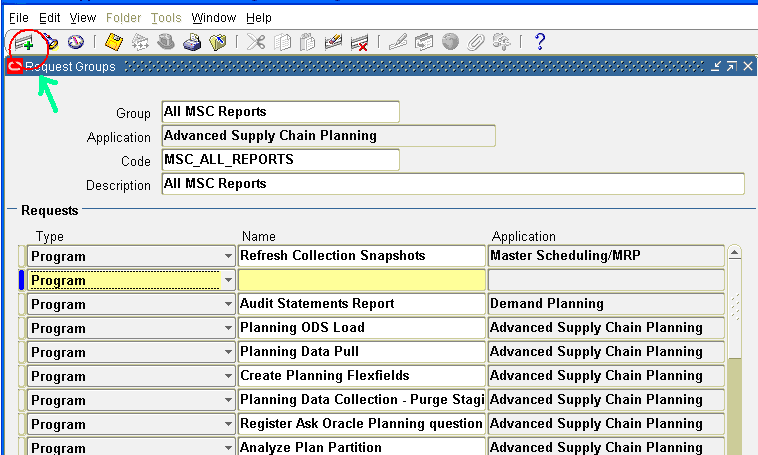
Place cursor in the name column, Click the plus sign (Green +) on the toolbar to create a “New” column.
In the name column select “CREATE APS PARTITIONS” (Make sure to select the correct one) and the Save the record.
Switch responsibility to “Advanced supply chain planner”.
Navigate to Other Request
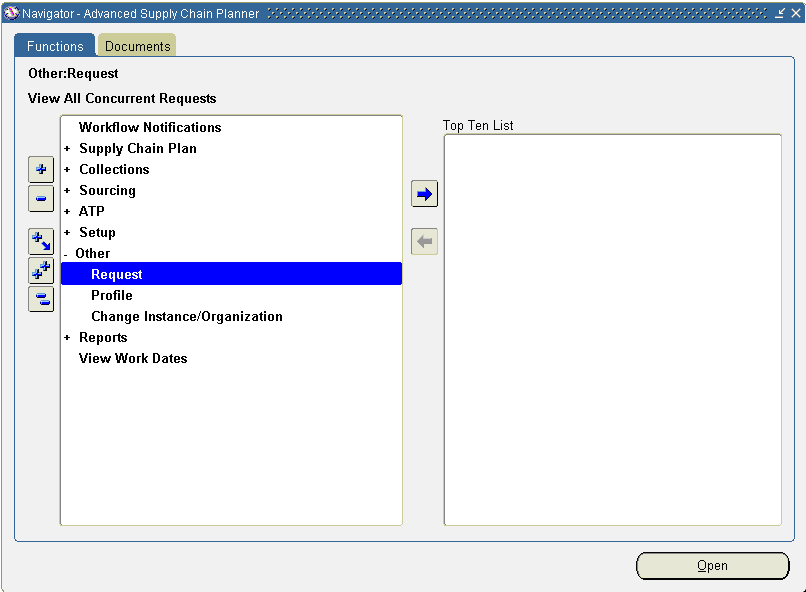
In the “Find Requests” screen click on the “Submit a New Request” “Single Request”.
Select “Create APS Partitions” request and submit it.
Check for the successful completion of this request.
Launch the Create Planning Flexfield Report
Task By: Functional Consultant
Launch the Create Planning Flexfields report from the newly created Advanced Supply Chain Planner responsibility. The parameters that must be set for the report are the attributes that you wish to utilize for the new flexfield definitions. The list of values for each parameter lists only the available attributes in the subject descriptive flexfield.
Matter
Create the Global Order Promising flexfilds.
Task By: Functional Consultant
[Not required this step in 11.5.10 and above]
Set up source data
Task By: Functional Consultant
Set up source data with BOMs, resources, routings, supplier data, flexfields purchasing information, item masters, Oracle BIS targets, and any other data required by your plans.
[Not required this step in 11.5.10 and above]
Set System Profile Values
Task By: Functional Consultant
If Global Order Promising is going to be utilized, the following two additional profile options must be set.
MRP:ATP Database Link: [Database Link Name on the Source System for the Target System]
INV: External ATP : [None]
Prepare the Target System
Define the source instance to be collected from
Task By: Apps DBA
The define instances setup establishes the means of communication between the source and destination instances. It also specifies the organizations in the source database for which data will be pulled.
Logged in to the Target (ASCP) System and choose “Advanced Planning Administrator”.
Navigate to Admin Instances. The Application Instances window appears.
Insert record for the Source (ERP) system as follows:
Instance Code : Give a new name for the Instance Code (uniquely identified).
Instance Type : Select “Discrete” (consult Functional Consultant).
Version : 11i (default, for 11i E Business Suite).
From Source to APS : Database Link created on the Source System for Target System Database.
From APS to Source : Database Link created on the Target System for Source System Database.
Check “Enable Flag”, “Allow ATP” and “Allow Release”.
GMT Difference : “-8” (this is Application location specific, consult Functional consultant).
Currency : USA (this is Application location specific, consult Functional consultant).
Assignment Set : (Kept this blank unless advised by Functional Consultant).
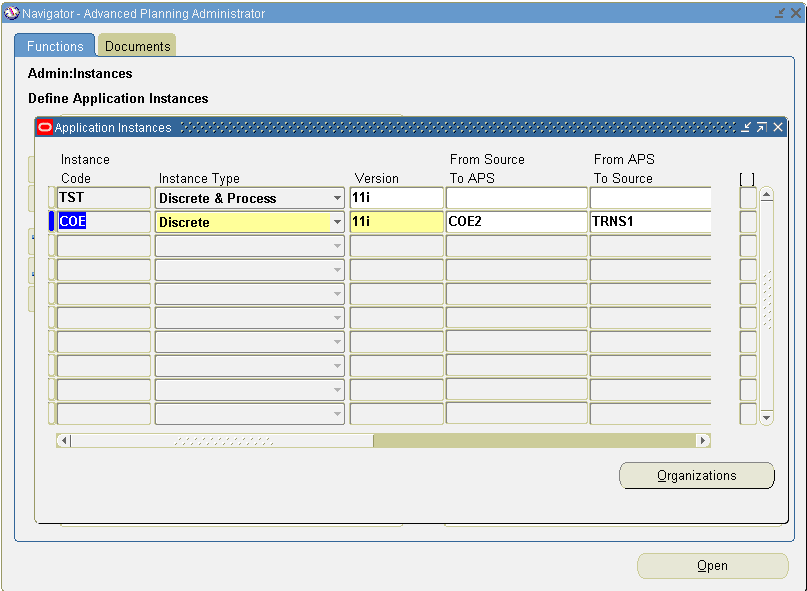
Save the record.
Enter the organizations on each of the instance from which to collect the Planning data and plan for on the Planning Server by clicking Organization. For this click on the “Organizations” button.
The Organizations window appears.
Select the organizations for a particular instance. Be sure to select the master organization.
Close the Organization window.
Save the Instance Definition setup.
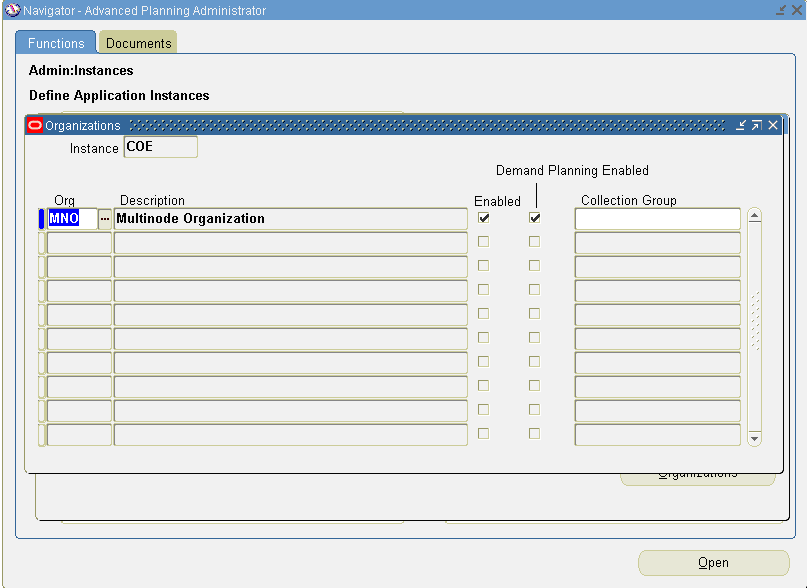
Final Setups and Refreshing Snapshots
Setups
Task By: Apps DBA
1. Make sure the responsible name on both source & destination are the same. Eg. “Advanced Supply Chain Planner”.
2. Set Standard Manager to 15 [sysadmin Concurrent Manager Define] on both System and Target Application system.
3. Set MRP Manager to 1 [sysadmin Concurrent Manager Define] on both System and Target Application system.
4. Relink MSC,MRP module from adadmin on Target (ASCP) DB node.
5. Execute this request “Gather Schema Statistics” on Source (ERP) and Target (ASCP) node.
6. Set “MSC:Source Setup Required” to “Y” in Target (ASCP) System, set “N” in Source (ERP) System.
7. Run “Refresh Collection Snapshots” from Source (ERP) instance.
Execute the Refresh Snapshot concurrent program on the Source (ERP) System
Task By: Functional Consultant
The “Refresh Collection Snapshots” process must be run on the source (ERP) instance. This concurrent program is available in the Advanced Supply Chain Planner responsibility created earlier. The process has no parameters to be set at run time. Verify that the process completes without error.
References
Oracle Metalink.Notes
Note:226415.1: Oracle Advanced Planning and Scheduling Suite Release 11i Family Pack I About doc
Note:282678.1: About Oracle Advanced Supply Chain Planning in APS Family Pack I
Note:286852.1: Oracle Advanced Supply Chain Planning Release 11i Family Pack I About doc
Note:176030.1: APS Installation Checklist with Patchset G
Note:136734.1: Advanced Supply Chain Planning 11.5.3 Installation Checklist
Note:259322.1: About Oracle ASCP in the Oracle Supply Chain Management Family Pack J
Note:220304.1: Setting Up Instances For Data Collection Gives Partition Error ERR_GET_INSTANCES
Note:280052.1: Advanced Planning and Scheduling (APS) Implementation Notes & White Papers
Note:137293.1: How To Manage APS Partitions in the MSC Schema
Note:252108.1: How to Determine the Latest APS Rollup Patch Applied to the System
Note:209585.1: ASCP Planning Detail Report Installation and Configuration Instructions
Note:278055.1: Advanced Planning and Scheduling Requirements for 11.5.10 – Family Pack J
Note that the above mentioned notes were not necessarily used for ASCP Multi Node Installation, but they were studied. The Note required by the patches applied above are listed in its respective column.





